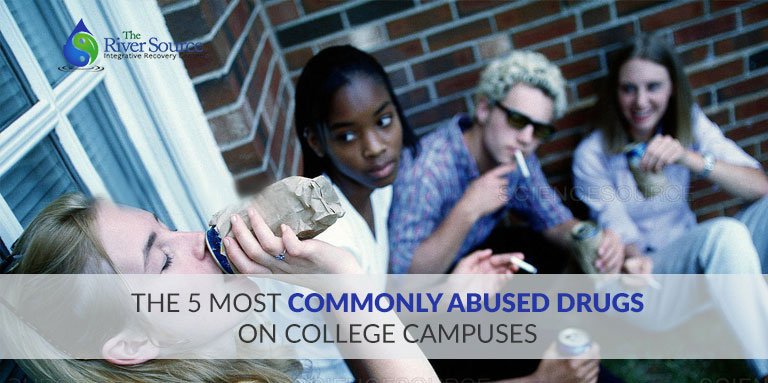
Drug use and abuse on college campuses are becoming more and more prevalent. While the tendency for college students to develop unsafe habits with alcohol is widely known, the commonness of drug use is often overlooked.
Which drugs are most commonly abused on college campuses? To find the answer, we looked at a study that took place from 2011 to 2014, in which nearly 25,000 college students were surveyed about drug use. Follow along as we highlight the results of this study, and learn about how they can impact you and your college-aged loved ones.
The Top 5 Drugs Abused by College Students
- Marijuana
Marijuana, also known as pot, weed, and a variety of other nicknames, is by far the most commonly used substance on college campuses. A study found that around 30% of college students had used marijuana since entry into their college or university, making it almost as frequent on campus as alcohol consumption.
- Hallucinogens
While not as common as marijuana, hallucinogenic drug use is also prevalent on college campuses as a means to relax. Many college students report using psilocybin mushrooms for their hallucinogenic effects or LSD, commonly known as acid, to cope with the stress of often-challenging university coursework.
- Prescription Opioids
Prescription opioid abuse has skyrocketed in nearly all populations nationwide, so it’s no surprise that college campuses haven’t been excluded: between 1999 and 2005, non-medical opioid use by students increased by 343%. In some schools, the problem has become so prevalent that campus police are arming themselves with life-saving doses of Narcan to respond to opioid overdoses.
- Cocaine
Cocaine is a potent stimulant, often ingested nasally for a quick high at parties and other social events in college. One study found that 36% of college students reported being offered cocaine while in school, and 13% reported using it while they were students.
- Stimulants
Stimulant use is high in colleges across the country for various reasons. ADHD medications are often abused by students to boost their focus when studying, and amphetamines (like MDMA and Molly) are abused for a prolonged high. Today, more emergency room visits than ever are occurring due to non-medical use of “study drugs” like Adderall.
High Potential for the Gateway Effect
One of the largest concerns in regard to the prevalence of drugs on college campuses is that casual use can lead to abuse and addiction. Many of the substances used by college students are referred to as “gateway drugs.” It is important for parents to know the “slang” words for street drugs in college. The theory behind “gateway drugs” claims that there are certain substances that when abused, naturally lead to abuse of other, and often times more harmful, substances. Marijuana was long thought to be the leader of this category, and while there is no consensus from the scientific community on this claim, substances like marijuana and alcohol can escalate an issue with substance abuse.
It’s also true that using prescription drugs for non-medical purposes can lead to addiction of illicit drugs of the same category. For example, abuse of prescription pain pills can lead to addiction to heroin, and abuse of prescription amphetamines, such as Adderall, can escalate to methamphetamine use.
How to Talk to Your Student About Drug Use
If you have loved ones attending college, you may be considering the best ways to communicate with them about drugs. The failures of the once-popular D.A.R.E. program show that fear tactics aren’t effective, and neither is ignoring the problem altogether.
When you approach the issue of drugs with your child or other college-aged loved ones, think about how you do it. The best plan of action is to open a communication channel about drugs early and come back to it on a regular basis.
Frame drug and alcohol abuse as a serious health issue, rather than a moral issue. Talk about how college is a time for trying new things, but there are still consequences to drug and alcohol use and abuse. Many of the drugs used on campus aren’t legal there, or anywhere, and the effects of a single mistake can be life-changing.
Student Resources for Sobriety
There are many resources available to college students seeking guidance on substance use. The DEA’s Campus Drug Prevention library connects youth and college-aged students with resources in their area to resist drugs at times when temptation may be at its peak. Additionally, many colleges and universities nationwide have resources aimed at helping students navigate the higher education system while maintaining their sobriety.
